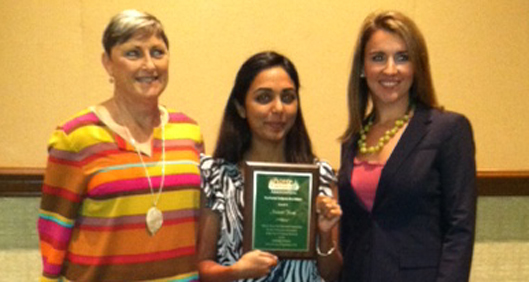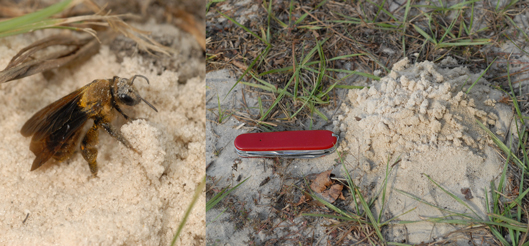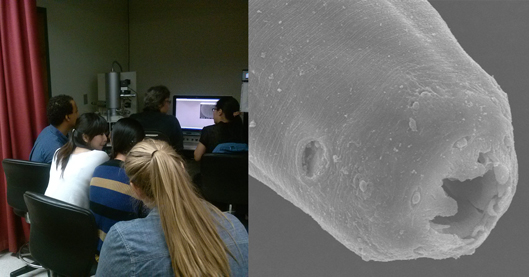- Faculty News
- Student News
- Lab News
- Publications
- Meetings and Presentations
- Outreach
- Grants
- Announcements
- About This Newsletter

ABOVE: This Jack o' lantern features the Doctor of Plant Medicine caduceus and is the first sign that autumn is here, and it is time to think about a Thanksgiving menu. Looking for a change in menu items? At the bottom of the newsletter are two traditional menus dating back to 1885.
Dr. Phil Stansly based at the Southwest Florida Research and Education Center in Immokalee, has been appointed interim director of that facility. Read more in this article by The Grower.
 On September 30th, the Florida Museum of Natural History’s Science Café featured speakers Dr. Andrea Lucky and Dr. Jiri Hulcr. The title of the program was "The beauty and complexity of insects, fungi and microbes under (and on) your feet."
On September 30th, the Florida Museum of Natural History’s Science Café featured speakers Dr. Andrea Lucky and Dr. Jiri Hulcr. The title of the program was "The beauty and complexity of insects, fungi and microbes under (and on) your feet."
The event was held at the Saboré restaurant in Town of Tioga. Learn more about upcoming science café events on the museums website.
 Dr. Jeff Bloomquist gave two lectures, one on "Insecticide modes of action" and one on "Resistance mechanisms and management" at the Agrarian National University The Molina in Lima, Peru, in July. This activity was part of a Distinguished Lectures series funded by the American Chemical Society, Division of Agrochemicals.
Dr. Jeff Bloomquist gave two lectures, one on "Insecticide modes of action" and one on "Resistance mechanisms and management" at the Agrarian National University The Molina in Lima, Peru, in July. This activity was part of a Distinguished Lectures series funded by the American Chemical Society, Division of Agrochemicals.
 Special thanks to the faculty members who served as mentors in the UF Student Science Training Program (STTP) last summer. Dr. James Cuda, Dr. Marjorie Hoy and Dr. John Sivinski.
Special thanks to the faculty members who served as mentors in the UF Student Science Training Program (STTP) last summer. Dr. James Cuda, Dr. Marjorie Hoy and Dr. John Sivinski.
 Dr. Nan-Yao Su has been in the news again with this catchy title: Termites' powerful weapon against extermination? Their own poop. You can find the complete list of authors and the citation for the publication that caused this media frenzy below in the list of publications.
Dr. Nan-Yao Su has been in the news again with this catchy title: Termites' powerful weapon against extermination? Their own poop. You can find the complete list of authors and the citation for the publication that caused this media frenzy below in the list of publications.
Crystal Snodgrass (B.S. 2003 and M.S. 2005) received the CALS Alumni and Friends Horizon Award during the IFAS/CALS TailGATOR weekend ceremonies.
 Ms. Lacey Jenson (Ph.D. student in the Bloomquist lab) won first prize ($300) in the student poster competition at the 2013 national meeting of the American Chemical Society, AGRO division, in Indianapolis, IN.
Ms. Lacey Jenson (Ph.D. student in the Bloomquist lab) won first prize ($300) in the student poster competition at the 2013 national meeting of the American Chemical Society, AGRO division, in Indianapolis, IN.


ABOVE: Ms. Navneet Kaur (in the Buss lab) received the Col. Frank Ward Memorial Scholarship ($1,500) from the Florida Turfgrass Association and Research Foundation Inc." during the Florida Turfgrass Association's 61st Annual Conference and Show held on September 11th at the Caribe Royale in Orlando, Florida.
 Recent graduate Dr. Court Whelan from the Department's Ecotourism Entomology program has accepted the position of Conservation Travel Specialist at the leading ecotourism company in the U.S., Natural Habitat Adventures. Working closely with the World Wildlife Fund, Court will be actively planning, marketing, and leading trips for VIP members of the World Wildlife Fund through their Conservation Journeys program. From tracking snow leopards in Mongolia to kayaking down the Okavango delta, the Conservation Journeys program functions to engage the world's most influential advocates of conservation by offering unprecedented access to the world's most intriguing and inspiring nature destinations.
Recent graduate Dr. Court Whelan from the Department's Ecotourism Entomology program has accepted the position of Conservation Travel Specialist at the leading ecotourism company in the U.S., Natural Habitat Adventures. Working closely with the World Wildlife Fund, Court will be actively planning, marketing, and leading trips for VIP members of the World Wildlife Fund through their Conservation Journeys program. From tracking snow leopards in Mongolia to kayaking down the Okavango delta, the Conservation Journeys program functions to engage the world's most influential advocates of conservation by offering unprecedented access to the world's most intriguing and inspiring nature destinations.
 Dr. Daniel Swale (Ph.D. 12/2012, from the Bloomquist lab) was the winner of the 2013 American Chemistry Society AGRO Division New Investigator Award ($1000) at the national meeting in Indianapolis, IN.
Dr. Daniel Swale (Ph.D. 12/2012, from the Bloomquist lab) was the winner of the 2013 American Chemistry Society AGRO Division New Investigator Award ($1000) at the national meeting in Indianapolis, IN.
Need to name that bug? A host of experts are available to help Floridians identify any insect or related arthropod. If a mystery creature has six or more legs, the UF Insect ID Lab is the place to call.

ABOVE: Lyle received a call from a homeowner in Tampa concerning some large wasps flying in her yard. She thought they were cicada killers, but late September is rather late for cicadas and cicada killer wasps to be active. They turned out to be a large bee, Dieunomia heteropoda (family Halictidae) (on the left). Although it is a solitary species, it may nest in large aggregations of dozens of individuals. They tunnel into the sandy soil and provision their nests with pollen gathered from flowers in the family Asteraceae. Although these bees are large, nearly ¾ inch long, they are not aggressive and are unlikely to sting. The female creates a large mound of sand as she digs her tunnel (on the right).
Lyle Buss is the Insect ID Lab manager.
 Think it might be a nematode problem? The Nematode Assay Laboratory serves Florida and other states by providing nematode assays and expert advice regarding nematode management.
Think it might be a nematode problem? The Nematode Assay Laboratory serves Florida and other states by providing nematode assays and expert advice regarding nematode management.

ABOVE: On the left, students in the Molecular Systematics class learn about SEM. On the right is a SEM photo taken by the students (anterior region of the free-living Mononchus nematode).
For more information on the Nematode Assay Laboratory please contact the lab manager Dr. Tesfa Mengistu.
Chouvenc T, Efstathion CA, Elliott ML, Su N-Y. 2013. Extended disease resistance emerging from the faecal nest of a subterranean termite. Proceedings of the Royal Society doi:10.1098/rspb.2013.1885.
Dongyoung S, Richards SL, Alto BW, Bettinardi D, Smartt CT. 2013.
Genome sequence analysis of dengue virus 1 isolated in Key West, Florida. PLoS ONE 8(9): e74582. doi:10.1371/journal.pone.0074582.
Gill HK, McSorley R, Goyal G. 2013. Soil solarization and organic mulches: tools for pest management, pp. 301-324. In: Dhawan AK, Singh B, Brar-Bhullar M, Arora R (eds.). Integrated Pest Management. Scientific Publishers, Jodhpur, India.
Keathley CP, Stelinski LL, Lapointe SL. 2013. Attraction of a native Florida leafminer, Phyllocnistis insignis (Lepidoptera: Gracillariidae), to pheromone of an invasive citrus leafminer, P. citrella: evidence for mating disruption of a native non-target species. Florida Entomologist 96: 877-886.
Miller CW, Hamel J, Holmes KD, Helmey-Hartman WL, Lopatto D. 2013. Expanding your research team: learning gains when a laboratory partners with a classroom. Bioscience 63: 754-762.
Moore MR, Jameson ML. 2013. Taxonomic and nomenclatural changes in the pelidnotine scarabs (Coleoptera: Scarabaeidae: Rutelinae: Rutelini). The Coleopterists Bulletin 67: 377-388.
Moore MR, Jameson ML. 2013. Floral associations of cyclocephaline scarab beetles. Journal of Insect Science 13: 1-43.
Nyoike TW, Liburd OE. 2013. Effect of Tetranychus urticae Koch (Acari: Tetranychidae) on marketable yields of field-grown strawberries in north-central Florida. Journal of Economic Entomology 106: 1757-1766.
Oliferenko PV, Oliferenko AA, Poda GI, Osolodkin DI, Pillai GG, Bernier UR, Tsikolia M, Agramonte NM, Clark GG, Linthicum KJ. 2013. Promising Aedes aegypti repellent chemotypes identified through integrated QSAR, virtual screening, synthesis, and bioassay. PLoS ONE 8(9): e64547. doi:10.1371/journal.pone.0064547
Taravati S, Mannion C, Glenn H, Osborne L. 2013. Natural enemies of rugose spiraling whitefly, Aleurodicus rugioperculatus Martin (Insecta: Hemiptera: Aleyrodidae) in the south Florida landscape. University of Florida, IFAS Extension, Electronic Data Information Source (EDIS). ENY-870.
Spence DJ, Smith JA, J. Hulcr, Ploetz R, Stelinski LL. 2013. Effect of chipping on emergence of the redbay ambrosia beetle (Coleoptera: Curculionidae: Scolytinae) and recovery of the laurel wilt pathogen from infested wood chips. Journal of Economic Entomology 106: 2093-2100.
Xing L, Chouvenc T, Su N-Y. 2013. Molting process in the formosan subterranean termite (Isoptera: Rhinotermitidae). Annals of the Entomological Society of America 106: 619-625.
Other publication news:
The following peer-reviewed paper was selected as the "Editors Choice" by Medical and Veterinary Entomology.
Costanzo KS, Muturi EJ, Montgomery AV, Alto BW. 2013. Effect of oral infection of La Crosse virus on survival and fecundity of native Ochlerotatus triseriatus and invasive Stegomyia albopicta. Medical and Veterinary Entomology doi:10.1111/mve.12018.
 New on Featured Creatures:
New on Featured Creatures:
Do you have a favorite creature? Learn how to make it into a Featured Creature!rat lungworm, Angiostrongylus cantonensis (Chen, 1935). Authors: John Capinera Entomology and Nematology Department, University of Florida, and Heather S. Walden, Infectious Diseases and Pathology, University of Florida.
spotted cucumber beetle, Diabrotica undecimpunctata howardi Barber. Authors: Harsimran Kaur Gill, Gaurav Goyal and Jennifer Gillett-Kaufman, Entomology and Nematology Department, University of Florida
Dr. Billy Crow presented "Nematode management on bermudagrass" to the Georgia Golf Course Superintendents Association at St. Simon's Island, GA, on September 16th.

From the Outreach Coordinator
The live critters are always a hit with children and adults alike. The critters are available for you to check out should you be leading an outreach event. We have doubles of our most popular critters, as well as various native insect species depending on the time of year. We have large wood and Plexiglas cages for viewing our native orb weaving spiders. There is one travel cage and one larger static cage. Please be sure to contact us and review the protocol on transporting and handling the critters if you are not already familiar with it. If you lead an outreach, be sure to fill out a documentation form so your event can be included in the newsletter and we can log all outreach events.
If you would like to schedule an event or have any outreach questions, go to the Outreach pages on our Bug Club Website and contact us. I look forward to working with all of you over the next four years.
- Stephanie Stocks, Outreach Coordinator
- Office number 352-273-3958
Virni Mattson, our grants specialist, reports that from September 1st to September 30th, 2013, we have had 18 new grants or contracts awarded for a total of $548,017.82 in external funding for all Entomology & Nematology faculty (in Gainesville and at RECs). Please note that one of the awards is actually a deobligation of funds (~$8,000).
This fall we have a wide diversity of speakers and topics for the Departmental Seminar Series. Research topics include stress tolerance in Antarctic insects, bacteriophages and symbioses, communication in jumping spiders, and diversity in Coleoptera. There are also a few seminars with practical applications in mind including how to get involved in online education, how to bring GIS into your research, and how to deal with binary data.
 September 2013 Edition of DPM News
September 2013 Edition of DPM News
DPM News is a new biannual publication for stakeholders, alumni, prospective students, and friends of the DPM program. Feel free to distribute DPM News to other interested individuals. Archived editions of DPM News will be housed on the DPM website. The DPM program would like to invite our newsletter readers to like their Facebook page to keep up with DPM events and developments. Be sure and "like" the DPM Facebook page.
The Honey Bee Research and Extension lab is pleased to announce the Fall UF/IFAS Master Beekeeper Program (MBP) training and exams on October 31st at the Washington County Extension Office in Chipley, Florida. New beekeepers are welcome to register and test at the apprentice level; a passing score grants entry to the MBP (please see link below for additional requirements). MBP participants are welcome to register and test for program advancement and additional training.
There will be a lot happening at the Washington Co. Ext. Office over the three days, and we highly encourage you to take advantage of this unique opportunity. This is the first time the UF/IFAS Master Beekeeper Program, the FSBA Convention, and the Panhandle’s Beekeeper Field Day & Trade Show are joining together!
Honey Bee Research and Extension Laboratory invites you to follow them on Twitter to find out about upcoming events and interesting stories about honey bees @UFHoneybeelab.
 Getting social!
Getting social!
We have several social media sites for the Entomology & Nematology Department. To make them easily searchable, all three (YouTube, Facebook and Twitter) have the same page name: UFEntomology. Please share these links with past students or colleagues who may have an interest in departmental activities.
 Hungry?
Hungry?
Autumn is here, and it is time to think about a Thanksgiving menu. Following are two ‘traditional’ menus dating back to 1885. How can anyone resist? If you make any of these menu items, please send us a picture and a recipe review!
Menu One: Snail Soup. Fried Soles, with Woodlouse Sauce. Curried Cockchafers. Fricassée of Chicken with Chrysalids. Boiled Neck of Mutton with Wireworm Sauce. Ducklings, with Green Peas. Cauliflower Garnished with Caterpillars. And who can resist... Moths on Toast.
Menu Two: Slug Soup. Boiled Cod with Snail Sauce. Wasp Grubs Fried in the Comb. Moths Sautéd in Butter. Braized Beef with Caterpillars. New Carrots with Wireworm Sauce. Gooseberry Cream with Sawflies. Deviled Chafer Grubs. Stag Beetle larvae on Toast.
Source: Holt, V.M. 1885. Why not eat insects? Field and Tuer, The Leadenhall Press, London. 99 pp.
Dr. Jennifer Gillett-Kaufman is the newsletter editor and does the HTML coding. Issues usually are published by mid-month. Submit items for an issue by the 7th of that month.
We like to share news when it happens using our social media outlets: Twitter, Facebook and YouTube. Follow us on these sites for daily updates! When you send news, we will post it on one or more of these sites and again in the monthly newsletter. Please be sure you have permission from people in photographs you submit for publication.
UF-Bugnews-L listserv subscribers receive notices when issues are posted. Our home page has instructions for subscribing and unsubscribing.
Special thanks to Dr. Verena Lietze and Nancy Sanders who reviewed the newsletter for errors and to Jane Medley and Don Wasik who built the web page design.